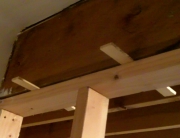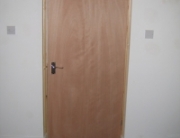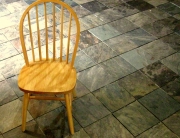To accompany the video “How to Rewire a Lamp.”
Electrical Safety Precautions
The power of electricity should be respected. Electricians take basic safety precautions when working with electricity, and so should every do-it-yourselfer, to keep yourself and your family safe.
Before proceeding with the job, read and observe the following safety guidelines.
– Always shut off the power to the circuit on which you will be working. If you are unsure, shut off the power at the main breaker.
– Post a warning sign on the breaker box to let others in the house know that you are working on the electricity, and to not touch the box. Lock the box if possible. Make sure that children and pets are not present in the working area.
– Test all the wires in the open box to be sure they are dead, not just the ones you will be working on. Never assume that a box contains just one circuit. The best way to check this is with a voltage tester.
– Even after turning off the power, work as if the wires are live. Work in a methodical manner and double check the security of all connections before restoring the power.
– Wear protective shoes and clothing. Always wear rubber-soled shoes. Never work with wet feet or while standing on a wet surface. Avoid jewelry, a watch, or clothing items that might get snagged while you are working.
– Don’t touch any metal while working. Make sure you grab tools by the handle (rubber-gripped tools are best). If you need to use a ladder, use a fiberglass or wooden one, NOT aluminum.
– Special Note: It is dangerous and is against code to connect copper to aluminum wire.
Resources Needed to Complete Job
Tools & Equipment
o Needle-nose Pliers
o Wire stripping tool
o Phillips and flathead screwdriver
o Multi-purpose tool or utility knife
o New socket, and new cord, with the plug attached.
General Supplies
o Electrical tape
Steps to Complete Job
Remove Existing Cord and Socket
1. The very first step is to take the appropriate safety precautions. If you have not already done so, review and observe the safety precautions listed in detail on page 1.
2. Turn the lamp over to expose the base. If you need to, remove any covering (usually a piece of cardboard covered in felt).
3. With the cutter on your wire-stripping tool, cut the cord.
4. With your screwdriver, loosen the screw at the base of the socket.
5. Unscrew the socket by hand. Because you have cut the cord at the bottom of the lamp, you will be able to pull the socket right off.
6. Next, remove the socket shell from the socket, by sliding off the shell.
7. Safety note: You will notice that there is a piece of cardboard inside the shell. DO NOT remove the cardboard, as it provides needed insulation, protecting the metal shell from the electrical terminals on the socket.
Install New Socket and Cord
1. Look at the new cord. Make sure that you have enough bare wire to work with at the ends. You may need to separate the two wires a bit. If you need to, you can very carefully separate the two wires with your utility knife, being extremely careful to not nick the wire. You may also need to strip the sheathing, if your wire didn’t come pre-stripped, which you can do with your wire stripping tool.
2. Fish the wire through the base of lamp, up the conduit and through the top.
3. Feed the wire through the base cap of the socket.
4. Next, tie the two ends of the wire at the top of the lamp into an underwriter’s knot.
5. Identify which of the two wires is hot, and which is neutral. Hot wire attaches to brass, and neutral wire to silver. To identify which one is the hot wire and which one is the neutral wire, you will notice that the tip of each wire is colored; one is black, and one silver. The black wire is the hot wire, to be attached to the brass terminal, and the neutral wire is the silver, to be attached to the silver terminal. If, by chance, your wire isn’t colored on the tips, you will need to identify which wire is hot and which wire is neutral by the sheathing. Run your finger along the sheathing. The hot wire will have a smooth sheathing. The neutral wire will have a ridged sheathing.
6. Attach the wires to the corresponding terminals. Put a hook into each wire, and attach to the corresponding screw on the socket. Tighten with a screwdriver so that there is a secure connection.
7. Reattach the socket shell. Slide it right over the socket. Again, be certain that your cardboard insulation is intact.
8. Attach the socket shell to the base. Pull the wire taut so that it seats well.
9. Put in a new light bulb, and test your newly rewired lamp!
And that is it. You did it!
Note: It is the intention of See Jane Drill to educate and empower people to perform their own home repairs. However, if, after viewing the video and reading the safety precautions and instructions, you still feel uncomfortable with performing an electrical job, you may want to call an electrician. Safety is the number one priority.
Due to differing conditions, tools, and individual skills, See Jane Drill assumes no responsibility for any mistakes, damages, injuries suffered, or losses incurred as a result of following the information published on our website and in the videos and written instructions published through our website. Before beginning any project, review the instructions carefully, and if you still have any doubts or questions about how to complete the project, consult with local experts or authorities. Also, because codes and regulations vary greatly by location, you should check to ensure that your project complies with all applicable local codes and regulations. Always read and follow all the safety precautions provided by any tool or equipment manufacturer, and follow all accepted safety procedures.
See Jane Drill is dedicated to providing accurate and helpful do-it-yourself information. We welcome your questions, input and feedback about the information provided on this website.
Copyright 2014, All Rights Reserved




Leave A Comment